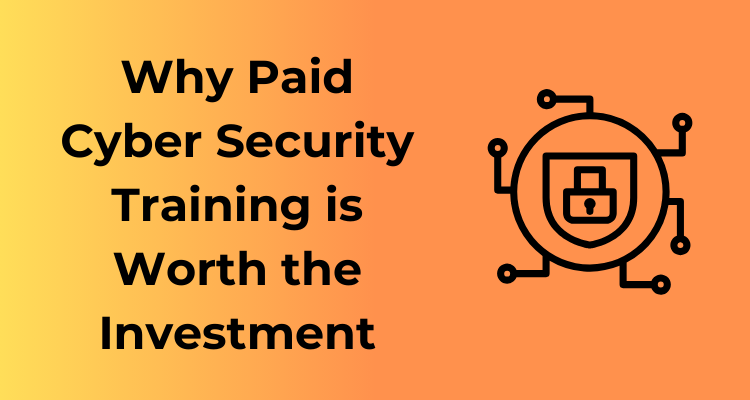Let’s face it: we live in a digitally connected world. From online banking and shopping to remote work and social media, our lives revolve around the internet. But with this connectivity comes risks—every year, countless organizations and individuals fall victim to cyber attacks. This growing threat has created a high demand for cyber security professionals who can safeguard sensitive information and critical systems. That’s where investing in cyber security training becomes invaluable.
You might be wondering, “Why should I pay for training when there are free resources out there?” It’s a fair question, and one that deserves a solid answer. Paid cyber security training often delivers structured, comprehensive, and up-to-date content that free resources simply can’t match. Think of it as a long-term investment in yourself and your future career.
The High Demand for Cyber Security Professionals

Here’s a fact that will grab your attention: the cyber security job market is booming. Reports suggest that as of 2023, there’s a massive talent gap in the industry, with hundreds of thousands of job openings worldwide. Organizations are desperate for skilled professionals who can fend off cyber threats, which translates into better job security and excellent salary opportunities for those with the right expertise.
So, what’s in it for you? If you’re someone thinking about a career change, or simply looking to add an in-demand skill set to your repertoire, paid cyber security training could be a golden ticket. It equips you with the tools and credentials employers are actively seeking.
More Than Just a Paycheck
Of course, the financial benefits are tempting—who doesn’t want a well-paying job? But the real payoff comes down to significance. Cyber security professionals have the satisfaction of knowing they’re making a difference. Whether it’s protecting patient information in hospitals, preventing financial fraud, or safeguarding national infrastructure, you’ll play a critical role in keeping the digital world safe.
A Smart Financial Move
Let’s talk numbers. Yes, paid training is an upfront cost, but it’s one that more than pays for itself. Consider this: according to reports, the average salary for cyber security professionals in the U.S. is *north of $100,000 per year*, depending on the role and certifications you hold. By investing in targeted, paid training, you position yourself to compete for lucrative and fulfilling opportunities.
Success Stories Speak Volumes
Want proof that people just like you are succeeding? There are countless stories of individuals who started from scratch, invested in reputable training programs, and went on to land dream jobs. From ethical hackers to risk managers, their journeys are clear examples that paid cyber security training is more than worth it when approached strategically.
Building Blocks: Skills Covered Under Paid Cyber Security Training
So, you’re thinking about investing in paid cyber security training? Fantastic choice! But what exactly will you be learning in these programs? Great question. Before you dive in headfirst, let’s break down the essential skills and knowledge areas you’ll typically encounter. Think of these as the building blocks of your cyber security expertise—tools you’ll wield as you defend digital systems from modern-day threats.
Understanding the Foundations
No matter which training program you choose, everything starts with the basics. You can’t effectively secure a system if you don’t fully understand how it works. Expect the early parts of your training to cover concepts like:
- Networking Fundamentals: It’s all about how devices talk to each other. If you’ve ever wondered how data flows through networks (or how attackers exploit that flow), here’s where you’ll find those answers.
- Operating Systems: From Windows to Linux, you’ll dive into how operating systems function—and how they can be exploited or secured.
- Cyber Security Basics: Want to know the difference between a virus, a worm, and a Trojan horse? These foundational elements ensure you understand the terminology and the bigger picture.
Hands-On Technical Skills
Paid training programs don’t just leave you in “theory land.” They want to develop your hands-on capabilities, because in the real world, you’re going to get your hands dirty (digitally, of course). Get ready to build technical chops in areas like:
- Penetration Testing: Also known as “pen testing,” this is where you’ll act like a hacker trying to breach a system’s defenses—in a controlled, ethical way. It’s practical, thrilling, and one of the most lucrative skills in cyber security.
- Incident Response: Learn how to detect, react to, and manage cyber security incidents under pressure. Spoiler alert: This field thrives on a “keep calm and carry on” energy.
- Malware Analysis: Ever wanted to reverse-engineer harmful software to discover how it functions? Paid training often includes tools and strategies for dissecting malware.
Specialized Expertise for Advanced Roles
As you progress, many courses let you branch into more specialized areas. These modules cater to niche roles in the industry, such as:
- Cloud Security: Companies are moving to the cloud at lightning speed, and understanding how to protect cloud-based data is a highly sought-after skill.
- Cryptography: You’ll explore the building blocks of secure communication, from encryption algorithms to public-key infrastructure.
- Governance and Compliance: This covers frameworks like GDPR, PCI-DSS, and ISO 27001 so you can ensure that organizations are following industry rules and regulations.
The Soft Skills You Never Knew You’d Need
Surprise! Cyber security isn’t just about technology; it’s also about communication and teamwork. Many quality training programs sprinkle in lessons on:
- Translating technical jargon for non-technical stakeholders (e.g., explaining risks to executives).
- Working with a security team to coordinate defenses and responses.
- Managing time effectively while prioritizing threats based on severity.
Standout Features to Look For in Paid Cyber Security Training Programs
When it comes to choosing a paid cyber security training program, you want to get the most bang for your buck, right? With so many options available, it can feel daunting to select one that truly stands out. But don’t worry, I’m here to help you navigate this maze and point out the key features that should make a training program a no-brainer for you to invest in.
1. Industry-Relevant Curriculum
This is a biggie! The cyber security landscape changes rapidly, with new threats emerging constantly. A good paid training program keeps its curriculum updated with the latest in the field. Look for courses that cover real-world issues like ransomware, malware analysis, penetration testing, and cloud security. Bonus points if they prepare you for current certifications like CompTIA Security+, CISSP, or Certified Ethical Hacker (CEH).
2. Hands-On Labs and Simulations
Theory is important, but cyber security is not something you can master by reading alone. Practical experience is what sets exceptional programs apart. Find courses that offer hands-on labs, virtual environments, or sandbox simulations where you can safely practice detecting and mitigating threats. Some platforms even create real-world attack scenarios for you to tackle—how cool is that?
3. Qualified and Experienced Instructors
Learning from seasoned pros can make all the difference. Check the profiles of instructors to ensure they come from strong cyber security backgrounds, ideally with certifications and frontline industry experience to their name. Their insights will give you not just textbook knowledge but also the practical know-how that employers value.
4. Certification Opportunities and Exam Prep
While gaining knowledge is great, having a certification in your arsenal adds credibility to your resume. Paid training programs often include modules tailored to help you ace certification exams. Look out for whether they offer exam vouchers, mock tests, or formal support as part of the package.
5. Flexible Learning Formats
Flexibility can make or break your ability to complete a course. Busy professionals or students need programs with multiple formats: live virtual classes, self-paced options, or even hybrid setups. Check if their schedule works with yours and make your life easier!
6. Career Support
What happens after you complete the course? Great training programs don’t leave you hanging. Look for those that offer job placement assistance, career counseling, or access to a network of employers. Some programs even host exclusive job fairs or partner with companies looking to fill cyber security roles.
7. Cost Transparency and Resources
- Is the pricing clear and fair? Avoid options with hidden fees.
- Does the program offer learning resources like downloadable guides, templates, or cheat sheets to aid your study process?
- Are there ongoing updates or lifetime access? Knowing this makes your investment worthwhile.
8. Community and Peer Networking
It’s not just about the instructors; a solid community environment can amplify your learning. A good training program fosters peer networking opportunities via forums, group projects, or virtual meetups. Building a network can be invaluable as you grow in this exciting industry.
Comparing Certification Paths and What They Offer for Career Growth
When it comes to cyber security, picking the right certification path can feel a bit like choosing a favorite dessert – there are plenty of great options, but the best one depends on your taste (or, in this case, career goals). Certifications play a crucial role in building your professional credibility and can act as a springboard for career advancement in this rapidly growing field. Let’s dive into comparing some of the most popular cyber security certifications and explore what they can offer for your career.
Why Certifications Matter
If you’re wondering whether certifications are worth the investment of time and money, let me tell you: they absolutely are! Certifications do more than just help you keep up with industry standards. They demonstrate to employers that you’re committed, skilled, and up-to-date with the latest in cyber security. It’s like a badge of trust that employers value in this field.
Popular Certification Paths
Here’s a quick rundown of common cyber security certifications and what makes each unique:
- CompTIA Security+: A fantastic entry-level certification for beginners. It covers foundational topics like network security, threat management, cryptography, and more. If you’re looking to break into the field, this is an excellent starting point.
- Certified Ethical Hacker (CEH): This course teaches you how to think and act like a hacker, with the noble goal of identifying and fixing vulnerabilities in systems. It’s ideal if penetration testing or ethical hacking piques your interest.
- Certified Information Systems Security Professional (CISSP): Known as the ‘gold standard’ in the industry, CISSP is designed for experienced professionals. It focuses on advanced topics like risk management, access control, and software development security. This one is perfect if you’re aiming for leadership roles.
- Certified Information Security Manager (CISM): Planning to move into management? CISM emphasizes governance, program development, and incident management. It’s tailored for those looking to bridge technical expertise with strategic leadership.
- Certified Cloud Security Professional (CCSP): As cloud technology continues to dominate, CCSP focuses on securing cloud-based environments. This is an excellent choice if you’re intrigued by cloud security.
Aligning Certifications with Career Goals
The key to selecting the right certification path is to align it with your career aspirations. Are you a hands-on tech enthusiast? Then certifications like CEH or Security+ might be your best bet. Planning to wear a managerial hat someday? CISM and CISSP target more senior roles. Interested in niche areas like cloud computing? CCSP could be the answer. Take some time to think about where you see yourself in a few years and let this guide your decision-making process.
Stacking Certifications Strategically
Don’t feel like you have to stick to just one certification! In fact, stacking certifications can help you develop a more robust skill set and stand out to potential employers. For example, you might start with the foundational CompTIA Security+ and later pursue CISSP as you grow in your career. The possibilities are endless.
Online vs. In-Person: Which Training Mode Suits Your Schedule

When stepping into the world of cyber security training, one of the first decisions you’ll face is choosing between online or in-person programs. Both options have distinct advantages, and the best choice often comes down to your lifestyle, learning preferences, and long-term career goals. Let’s break it down to help you make an informed decision.
Your Schedule, Your Rules: Online Learning
Picture this: you’re sipping coffee in your favorite cozy spot while diving into the intricacies of network defense. Sound appealing? Then online training might be your ideal path! Here’s why so many people are gravitating toward this flexible option:
- Flexibility: Online courses let you learn at your own pace and on your own timetable. Whether you’re a full-time worker, busy parent, or night owl, you can fit coursework into your life.
- Location Independence: Train from anywhere in the world. No commute, no problem.
- Cost-Effective: Online programs often save you money on transportation, housing, or other campus-related expenses.
- Access to Global Expertise: Online learning can give you access to instructors and peers from around the globe, expanding your network and knowledge base.
However, the online route requires discipline and self-motivation. Make sure you’re up for the challenge of managing your time and avoiding distractions. Pro tip: Set a dedicated study schedule and treat it like a job—your cyber security skills (and future self) will thank you!
Face-to-Face and Immersive: In-Person Training
If you’re someone who thrives on face-to-face interactions and structured schedules, in-person training might be calling your name. Why? Let’s take a look:
- Real-Time Interaction: Need clarification? You can ask questions and receive immediate feedback from instructors.
- Hands-On Experiences: In-person programs often emphasize practical, lab-focused activities where you can immediately apply what you’ve learned.
- Networking Opportunities: Connecting with peers, mentors, and industry professionals in person can sometimes spark unique career opportunities.
- Built-In Accountability: Showing up to class keeps you on track, especially if you struggle with self-discipline.
As great as all this sounds, remember that in-person training comes with additional commitments. It requires you to be physically present, which might not work if you have a demanding job or family responsibilities. Additionally, in-person courses might cost more due to travel, lodging, and facility fees.
Which Mode Matches Your Style?
So, what’s the verdict? Here are three quick steps to help you decide:
- Audit Your Schedule: Ask yourself: Do I need flexibility, or can I commit to a fixed schedule?
- Assess Your Learning Style: Are you independent and tech-savvy, or do you thrive in a structured, interactive setting?
- Consider Your Goals: Think long-term. Will your chosen mode prepare you for the career path you envision?
In some cases, a hybrid approach might be available, combining the best of both worlds. Be sure to explore your options to choose what works for you.
Avoiding Common Mistakes When Choosing a Cyber Security Course
So, you’ve decided to invest in your future with a paid cyber security course—great choice! But with so many options out there, choosing the right course can feel like navigating a maze. Don’t worry; I’ve got your back! Let’s walk through some of the common mistakes learners make when picking a course—and how to steer clear of them.
1. Not Researching the Course’s Credibility
First things first: not all courses are created equal. A polished website or hefty price tag doesn’t always mean a program is high-quality or well-respected in the field. To avoid wasting time and money:
- Check whether the course is offered or endorsed by reputable organizations or institutions.
- Look up reviews and feedback from former students. What did they gain? Was the program worth it?
- See if the program aligns with well-known cyber security certifications, like CISSP, CompTIA Security+, or CEH.
Think of this step as doing a background check—it’s worth the extra effort!
2. Ignoring Your Career Goals
This is a big one. Cyber security is a vast field that covers everything from penetration testing to security architecture. A general “one size fits all” course might not hone in on your desired area of expertise. Before enrolling, ask yourself:
- What path am I genuinely interested in: ethical hacking, network security, risk management?
- Do I need to develop practical technical skills, or am I looking for leadership-level concepts?
Once you’re clear on your goals, find a course that’s targeted and tailored to your needs. After all, you wouldn’t use a roadmap for Paris if you’re heading to Berlin!
3. Overlooking Hands-On Learning Opportunities
Here’s a little secret: some courses bombard you with theories and concepts but don’t actually teach you how to apply them. That’s a red flag! Cyber security is a hands-on field, and employers want professionals who can troubleshoot on the spot. Avoid this pitfall by finding programs that offer:
- Practical labs or virtual environments.
- Real-world projects or simulated attacks to solve.
- Access to tools commonly used in the industry, like Wireshark, Metasploit, or Splunk.
Getting your hands dirty in a controlled environment will boost your confidence and make your training 10x more effective.
4. Underestimating Time Commitment
You’re excited to start, but wait—are you sure you have the bandwidth to commit? Jumping headfirst into a course without factoring in your current workload or personal obligations can lead to burnout, or worse, dropping out. To avoid this:
- Look for programs that offer flexibility, like self-paced modules or hybrid schedules.
- Get a clear understanding of how long the course will take to complete.
- Create a realistic study schedule before you begin (your future self will thank you!).
5. Price Over Priorities
We get it—cyber security training can be expensive. But going for the cheapest program might not always give you the value or depth you need. Instead of just looking at the price tag, consider:
- What’s included in the course: access to instructors, community support, and job placement services can all be major bonuses.
- What certifications you’ll earn—some programs bundle exam fees!
- Whether the program offers lifetime access to material, so you can revisit lessons as the field evolves.
How Paid Training Paves the Way to In-Demand Jobs in Cyber Security
Let’s face it: the digital world is expanding faster than ever, and so are the risks that come with it. Cyber security is no longer an optional skill; it’s a necessity for businesses, governments, and even individuals. The good news is that investing in paid training can put you squarely in the driver’s seat for some of the most in-demand jobs in the industry. But how does this work? Let’s break it down!
Understanding the Demand in Cyber Security
Every time a new tech innovation enters the market, cyber threats evolve along with it. According to recent industry reports, there’s a massive talent gap in cyber security, with businesses struggling to fill vital roles. Companies are looking for skilled professionals who not only understand the intricacies of cyber defense but are also well-versed in problem-solving under pressure. This is where paid training comes in—it gives you the expertise and credentials to meet these demands head-on.
The Competitive Edge of Paid Training
Why opt for paid training when there are free resources available? Simple. Paid programs are often more comprehensive, industry-aligned, and hands-on. In short, they’re tailored to prepare you specifically for the job market. Here’s what paid training equips you with:
- Industry-Recognized Certifications: Most paid courses align their curricula with certifications like CISSP, CEH, or CompTIA Security+. These are the gold standard for employers and can significantly boost your resumes.
- Practical Experience: Unlike free resources, paid training usually offers real-world simulations and scenarios, such as penetration testing labs or incident response planning. This is your chance to practice what you’ll actually be doing on the job.
- Expert Guidance: Paid programs often connect you with seasoned instructors or mentors. Their insights can help you sidestep common pitfalls and break into the industry on the right foot.
Where Can Paid Training Take You?
Now here’s the exciting part. After completing a high-quality paid cyber security course, doors open to a variety of dynamic roles, such as:
- Security Analyst: Monitoring networks, identifying vulnerabilities, and fortifying defenses.
- Penetration Tester (Ethical Hacker): Testing systems for weaknesses by thinking like a hacker.
- Cyber Security Consultant: Advising organizations on strategies to protect their assets.
- Cloud Security Specialist: Safeguarding data and processes in cloud-based applications.
By paying for specialized training, you’re essentially fast-tracking your journey into one of these high-paying, future-proof jobs.
ROI: More Than Just Financial
While the monetary rewards in cyber security are enticing (think six-figure salaries for upper-level roles), the return on investment for paid training often goes beyond the paychecks. You’ll gain a sense of confidence and purpose knowing that your skills help protect organizations and individuals from potentially crippling digital threats.









